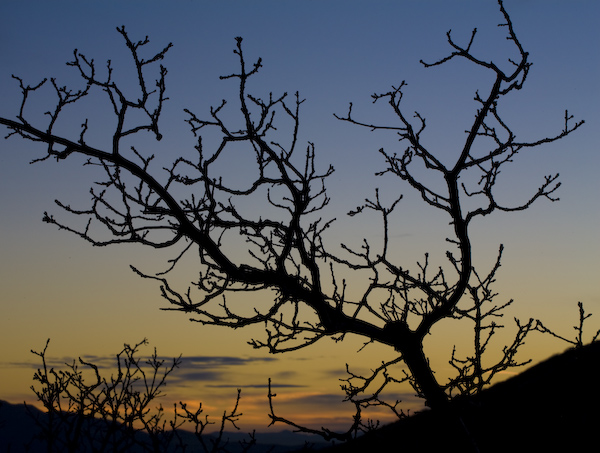Rescuing a Mediocre Sunset with Tree Silhouettes
A few times this past week I have seen some nice sunsets, though always when I didn’t have the time to do anything about it. As I’ve been thinking about this Tip of the Week entry, I had big plans of capturing a sunset picture in which the sky was ablaze with reds, oranges, and purples. At the appointed time (today), I drove up to a scouted location and waited. The glorious sunsets of the past week never quite rematerialized. This happens often to me. I previsualize my frame, plan it to the nth degree, and then reality doesn’t materialize quite as well as I had envisioned — clearly, not all the variables are in my control.
And so, the real quest began. There is a saying that when life hands you lemons, make lemonade! I didn’t have much time to waste, as what little color there was in the sky was quickly fading to black. I looked around to see what else I could capture that would be interesting photographically. Finally, I found it. The gradient sky, while not good enough on its own, was quite useful as a backdrop for a silhouette of oak branches.
These oaks have a rather distinct branching pattern. Many trees express great character through unique branching patterns. This pattern is best revealed when there are no leaves on the trees, so this time (and for the next few months before Spring) is ideal to see these branching patterns. Although a daylight photograph could show the branching pattern, it would do so with a lot of distracting information such as the color and texture of the bark. By using a silhouette, the trees are reduced to their elemental branching pattern. Silhouettes are easy to photograph as long as the subject is between you and the light source.
For this shot, I used a modest (100mm) telephoto lens, stopped down to f/22, and manually focused on some branches a little farther away than the very closest ones — kind of a manual hyperfocusing. I fully expected that the depth-of-field (especially at f/22) would be sufficient to bring the remaining branches into reasonable focus. With the dimming sunset light, a very small aperture, and a telephoto lens, I was brought down to an exposure of 1/8s shutter speed — plenty of justification for a tripod.
Splendid sunsets are wonderful to photograph and a rather risky proposition. When planning to photograph a sunset, arrive at your location early and look for other features (such as trees) to include in your frame, and consider what lens (or, more properly, focal length) will give the best perspective and composition with the trees you’ve found. Generally, a telephoto lens will be the easiest to to work with; a telephoto zoom is even more useful and flexible in this situation. A set of tree branches that are approximately equidistant from the camera will help you get more of the tree branches in focus. I will typically underexpose this type of a scene by approximately 2/3 of an f-stop relative to what the in-camera meter tells me; this prevents the colors from getting washed out, and helps blacken the silhouettes. Being thus prepared, you will be in a good position to rescue even a mediocre sunset.

Tip of the Week
2007.11.19

